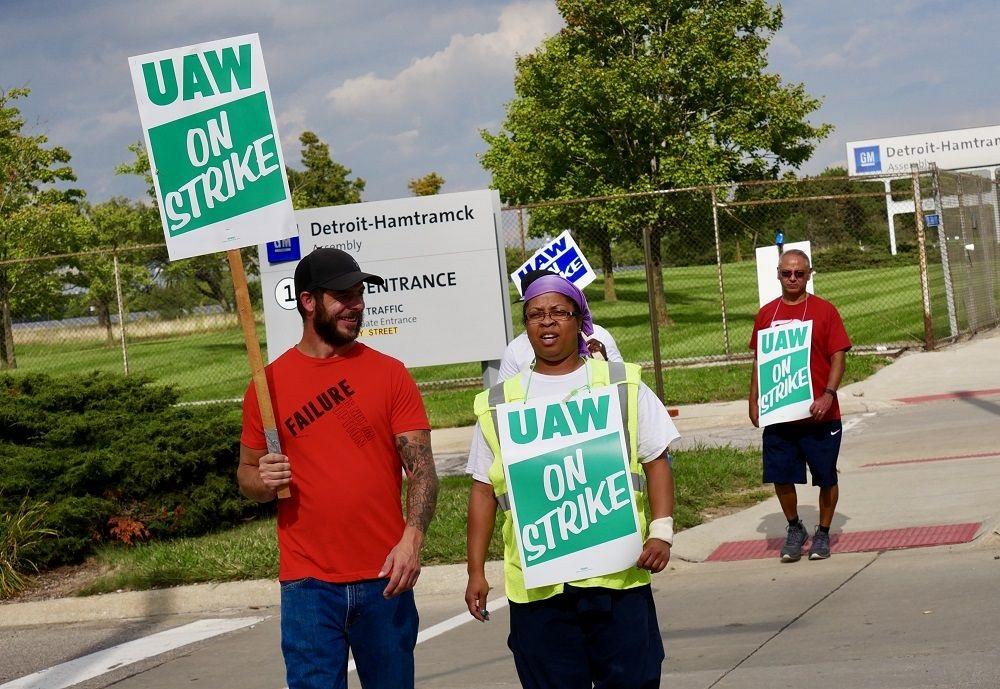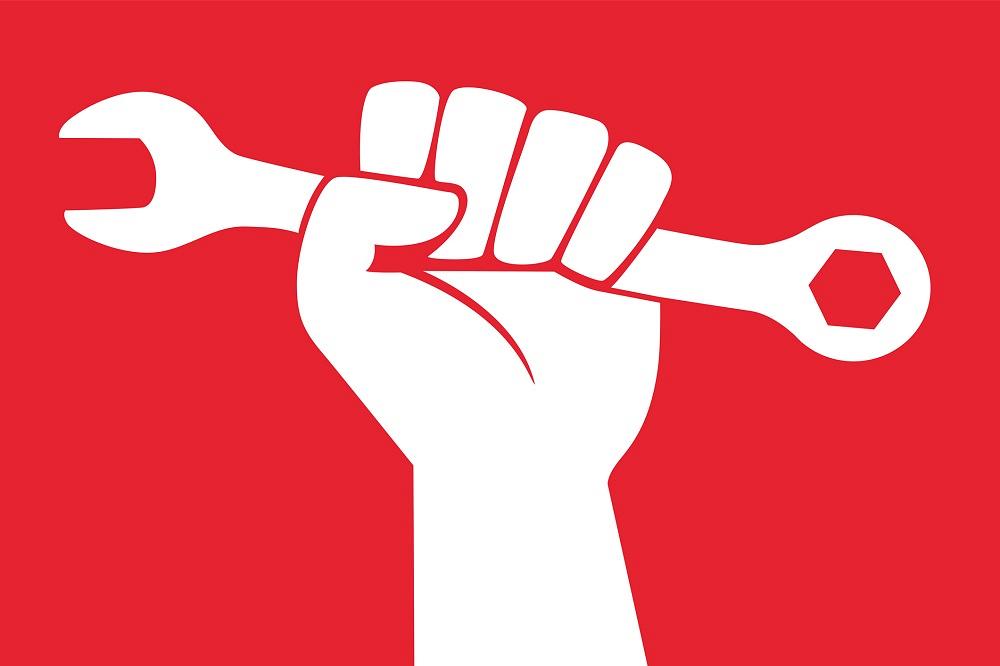Owner, Brown Dog Welding
- FMA
- The Fabricator
- FABTECH
- Canadian Metalworking
Categories
- Additive Manufacturing
- Aluminum Welding
- Arc Welding
- Assembly and Joining
- Automation and Robotics
- Bending and Forming
- Consumables
- Cutting and Weld Prep
- Electric Vehicles
- En Español
- Finishing
- Hydroforming
- Laser Cutting
- Laser Welding
- Machining
- Manufacturing Software
- Materials Handling
- Metals/Materials
- Oxyfuel Cutting
- Plasma Cutting
- Power Tools
- Punching and Other Holemaking
- Roll Forming
- Safety
- Sawing
- Shearing
- Shop Management
- Testing and Measuring
- Tube and Pipe Fabrication
- Tube and Pipe Production
- Waterjet Cutting
Industry Directory
Webcasts
Podcasts
FAB 40
Advertise
Subscribe
Account Login
Search
U.S. auto industry’s Big Three once again playing unfair with UAW
Ford, GM, and FCA continue to take advantage of union workers in current contract negotiation
- By Josh Welton
- UPDATED October 15, 2023
- September 16, 2019
It’s that time again. The U.S.’s Big Three automakers and the United Automobile Workers (UAW) are at war over the next four-year contract.
The big bosses at Ford, GM, and Fiat Chrysler Automobiles (FCA) want to continue to squeeze the laborers in the name of more profits, and the workforce is hoping to regain some of the wages they’ve lost over the last several contracts. Supposed impartial studies about the competitive disadvantages the Big Three face have leaked to the media, often with cherry-picked stats arguing against fairly compensating employees. Plants close, or are threatened with closure, to give the companies leverage.
Inside the plants, management has already begun nitpicking and selectively enforcing little-known rules so they can write up workers, holding their job and good name hostage – all for bargaining chips in local negotiations.
It doesn’t matter the circumstances; the Big Three bigwigs will turn the workforce into a ploy.
Nationally, the 2003 contract was reopened in 2005 for labor concessions due to a failing market. Automaker executives argued things like the compensation gap between unionized workers and nonunion car manufacturing employees was too wide.
In 2007, when the economy began its slide into a recession, is was the same. With the U.S. auto industry struggling, the Big Three asked their employees to make further concessions. Then during the bailout/bankruptcy in 2008-2009, the government and OEMs demanded more givebacks, basically saying, “Listen, we’re going bankrupt, the government is giving us billions to survive, you need to make massive concessions.”
Hell, the UAW ended up taking on the huge risk of shouldering retiree costs which, along with two tier wages, wiped out most of the UAW/non-UAW wage gap previously mentioned. In 2011 the Big Three continued to demand concessions with the excuse that the industry was still stabilizing and needed to stay competitive in the economy.
In 2015 Ford announced it was moving the production of small cars to Mexico right before negotiations opened. While the headlines after that contract talked about how “rich” it was, most of the gains were for the 30 percent low-tier hires. The Big Three used the bankruptcy a decade ago to push a two-tier wage system into the plants for factory workers. Now some factories have a higher percentage of lower-tier employees than higher-tier, which has a huge effect on what the rank and file will demand in their new contracts. In the last 19 years, real wages for Big Three hourly workers dropped a whopping 16 percent.
What really sparked my rant about the UAW contract dispute was this blurb from a recent story from the Detroit News:
“A new paper from the Ann Arbor-based Center for Automotive Research says GM's all-in hourly labor cost is $13 an hour higher than the ‘estimated weighted average of U.S. international producers,’ i.e., non-union rivals. The gap for Ford Motor Co. is $11 an hour. And for Fiat Chrysler Automobiles NV, it's $5 an hour. This is precisely the competitive disadvantage that two of Detroit's three automakers failed to close in bankruptcy a decade ago or in the bargaining rounds that followed.”
No, it’s not.

UAW workers on strike in Detroit in protest against what they consider to be unfair contract negotiations with Ford, GM, and FCA, Sept. 16, 2019. Photo by Darla Welton
They did close the gap. Most of it was the cost of retiree benefits. And don’t forget the UAW took a huge risk by taking responsibility for Voluntary Employees’ Beneficiary Association (VEBA). On top of that, you can’t take broad numbers and compare them to very specific numbers, like GM versus U.S. international producers.
You need to look at where the plants are: Alabama, Tennessee, and Texas, areas that have a lower cost of living than in Michigan. You need to look at the companies themselves: Are they similar? Toyota, which is the closest in size and production to GM and Ford, pays the same. Besides, whatever cuts the Big Three make to UAW workers, the U.S. international producers will do the same. They only pay well to keep the union out and keep pace with UAW hourly compensation, whether it’s up or down.
“All-in” costs included, well, everything. Like training and safety programs, which non-UAW companies tend to skimp on. Southern plants also tend to use more temp workers, also lowering all-in costs.
Speaking of labor costs, remember when the government derided the UAW Big Three for its Jobs Bank program? The program paid employees who would have otherwise been laid off. For the UAW, the benefits are obvious: Membership stays up and rank and- file get paid to train or do charity work.
On the other side, at least on the surface, it looked as though the companies were paying employees for nothing.
Now, consider this excerpt from an Automotive News editorial by Larry Vellequette written in April:
“There is no other business in this country where that would be tolerated,” an exasperated Sen. Bob Corker, R-Tenn., famously declared to the Detroit 3 CEOs and the UAW's president during the congressional bailout hearings in November 2008.
Corker was wrong, because just a few months after that declaration, Toyota Motor North America would quietly run one of the most successful jobs bank programs in industry history. And you know what? Even a decade later, Toyota's top executives in North America still insist that not only was it the right thing to do at the time, but it also saved Toyota money.
“The last recession, our belief was, while it was fairly deep, we didn't think that it was going to last for a protracted period of time, so it would have been crazy to lay people off, only to bring them back and retrain them,” recalled Jim Lentz, now CEO of Toyota Motor North America. “We felt it was best to do a lot of training, and once we've done all the training we could do, have people work in their communities to keep them on. I think that would always be our first direction.”
I bring this up because it shows just one example of Toyota running a very similar program that supposedly inflated Detroit’s all-in labor cost more efficiently. The Big 3 are inefficient above and beyond manpower. The knee-jerk reaction to any sort of massive compensation gap is always to look at the hourly wages of blue-collar workers. Heck, you want to look at paychecks? Compare GM CEO Mary Barra’s to what Toyota President Akio Toyoda made in 2018. Barra made $22 million to Toyoda’s $3.5 million. The exec-to-worker ratio doesn’t look so sweet for Detroit.
Negotiations this year have already been proven tough.
Stay educated, stand strong.
subscribe now

The Fabricator is North America's leading magazine for the metal forming and fabricating industry. The magazine delivers the news, technical articles, and case histories that enable fabricators to do their jobs more efficiently. The Fabricator has served the industry since 1970.
start your free subscriptionAbout the Author

- Stay connected from anywhere

Easily access valuable industry resources now with full access to the digital edition of The Fabricator.

Easily access valuable industry resources now with full access to the digital edition of The Welder.

Easily access valuable industry resources now with full access to the digital edition of The Tube and Pipe Journal.
- Podcasting
- Podcast:
- The Fabricator Podcast
- Published:
- 04/16/2024
- Running Time:
- 63:29
In this episode of The Fabricator Podcast, Caleb Chamberlain, co-founder and CEO of OSH Cut, discusses his company’s...
- Trending Articles
AI, machine learning, and the future of metal fabrication

Employee ownership: The best way to ensure engagement

Steel industry reacts to Nucor’s new weekly published HRC price

Dynamic Metal blossoms with each passing year

Metal fabrication management: A guide for new supervisors

- Industry Events
16th Annual Safety Conference
- April 30 - May 1, 2024
- Elgin,
Pipe and Tube Conference
- May 21 - 22, 2024
- Omaha, NE
World-Class Roll Forming Workshop
- June 5 - 6, 2024
- Louisville, KY
Advanced Laser Application Workshop
- June 25 - 27, 2024
- Novi, MI




























